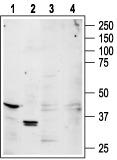Adenosine A1 Receptor (ADORA1) Rabbit Polyclonal Antibody
Other products for "ADORA1"
Specifications
| Product Data | |
| Applications | IF, IHC, WB |
| Recommended Dilution | WB: 1:200-1:2000; IHC: 1:100-1:3000 |
| Reactivities | Human, Mouse, Rat |
| Host | Rabbit |
| Clonality | Polyclonal |
| Immunogen | Peptide (C)KKVSASSGDPQKYYGKE, corresponding to amino acid residues 213-229 of human A1AR. 3rd intracellular loop. |
| Formulation | Lyophilized. Concentration before lyophilization ~0.8mg/ml (lot dependent, please refer to CoA along with shipment for actual concentration). Buffer before lyophilization: phosphate buffered saline (PBS), pH 7.4, 1% BSA, 0.05% NaN3. |
| Purification | Affinity purified on immobilized antigen. |
| Conjugation | Unconjugated |
| Storage | Store at -20°C as received. |
| Stability | Stable for 12 months from date of receipt. |
| Gene Name | adenosine A1 receptor |
| Database Link | |
| Background | Adenosine is an endogenous nucleoside generated locally in tissues under conditions of hypoxia, ischemia, or inflammation. It modulates a variety of physiological functions in many tissues including brain and heart.It exerts its action via four specific adenosine receptors (also named P1 purinergic receptors): A1-Adenosine Receptor (A1AR), A2A-Adenosine Receptor (A2AAR), A2B-Adenosine Receptor (A2BAR), and A3-Adenosine Receptor (A3AR). All are integral membrane proteins and members of the G Protein-Coupled Receptor superfamily. They share a common structure of seven putative transmembrane domains, an extracellular amino terminus, a cytoplasmic carboxyl terminus, and a third intracellular loop that is important in binding G proteins. The various adenosine receptors can be distinguished on the basis of their differential selectivity for adenosine analogs. A1AR is widely distributed and has been well characterized. High expression of A1AR is found in brain (mainly in the cortex, cerebellum, and hippocampus), dorsal horn of the spinal cord, adrenal gland, and atria, and to a lower extent in several other tissues including adipose tissue, colon, and kidney. A1AR modulates the activity of several ion channels. Activation of A1AR (by adenosine, its major agonist) inhibits N-type Ca2+ channels via a voltage-dependent, pertussis toxin (PTX)-sensitive pathway in neurons of the rat major pelvic ganglia (MPG). Since A1AR is the most prominent adenosine receptor in adipocytes, it has become a natural target for research on obesity, which is a major health problem. A possible role in cell proliferation and carcinogenesis has also been suggested for A1AR. |
| Synonyms | RDC7 |
| Reference Data | |
| Protein Families | Druggable Genome, GPCR, Transmembrane |
| Protein Pathways | Neuroactive ligand-receptor interaction |
Documents
| Product Manuals |
| FAQs |
{0} Product Review(s)
0 Product Review(s)
Submit review
Be the first one to submit a review
Product Citations
*Delivery time may vary from web posted schedule. Occasional delays may occur due to unforeseen
complexities in the preparation of your product. International customers may expect an additional 1-2 weeks
in shipping.






























































































































































































































































 Germany
Germany
 Japan
Japan
 United Kingdom
United Kingdom
 China
China






